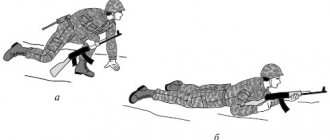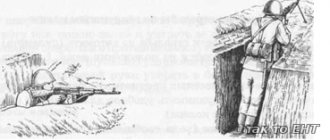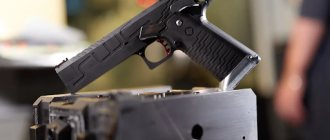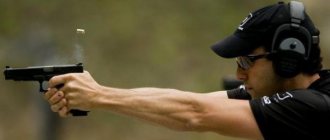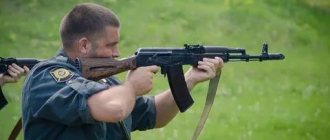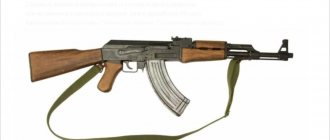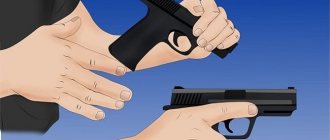Safety requirements for shooting are a list of rules that must be taken into account during any type of exercises and competitions. In order to achieve maximum safety when handling various small arms, specialized instructions have been developed in accordance with which the shooter should behave during training and control shooting, as well as while participating in competitions or performing command duty. By maintaining a high level of discipline, safety requirements during shooting make it possible to eliminate the possibility of accidents and also minimize risks to others.
Personal shooting
Checking whether the weapon is loaded should always be carried out individually. Safety requirements during shooting prohibit trusting people who hand over assembled weapons.
During training exercises, all rules must be followed in their entirety. It is prohibited to aim at people and other living beings, as well as to put at risk any objects of public or private property. Safety requirements for shooting include careful handling of weapons, regardless of whether they are loaded or not.
When cocking the hammer, the muzzle should be directed exclusively towards the target, and if necessary, it can be raised slightly upward. Without the need to fire a shot, it is prohibited to keep your finger on the trigger, as such actions can lead to various accidents, including traumatic and fatal situations. Before you begin shooting training, conducting combat operations, or leaving the house with a weapon, you need to check how serviceable it is, whether various mechanisms function correctly, and, in particular, note that the established position of the barrel corresponds to ordinary parameters. Also, regardless of whether you take an unloaded or loaded weapon, you need to check whether there are any unnecessary objects in the barrel.
Safety measures during shooting
1. Permission to open fire is given only by the shooting director or his assistant.
Fire is allowed upon commands “Fire!” or “Go!” from the firing line or firing lines according to the conditions of the exercise.
2. Shooting stops upon commands “Stop, cease fire!” , "All clear!" , or when people, cars, animals, as well as low-flying aircraft appear on the target field over the shooting area, when malfunctions of target equipment are detected, a fire occurs, delays in shooting, raising a white flag (lantern) at the command post or dugout (shelter) , when a signal is given by a white fire rocket.
3. Anti-noise headphones and protective glasses are put on and adjusted before the start of the exercise, and are removed at the command of the director or assistant director of shooting. In this case, these actions are performed in the absence of a weapon in the hands of the shooter.
4.When shooting with two hands from a weapon with a free-running bolt, the grip should be such that the bolt does not injure your hands.
5. The shooter should not touch the trigger (including in pauses between shots when shooting for an unlimited time), except for the moments of aiming and firing. In this case, the weapon must be pointed towards the targets.
6.If for some reason a cartridge is ejected from the chamber, then shooting should continue until all cartridges are used up, and at the end of shooting, report to the director or assistant director of shooting that the cartridges have not been used up.
During shooting it is prohibited:
1.Uncover or remove a weapon from a holster without the permission of the range director or assistant range director.
2. Point the weapon, whether loaded or not, toward where people are or in the direction they might appear.
3. Load a weapon with live or blank cartridges, without the command of the shooting director or assistant shooting director.
4.Open and fire without the command of the director or assistant director of shooting, from a faulty weapon, in dangerous directions (including outside the boundaries of the shooting range, shooting range or range), above bullet-proof ramparts or enclosing walls, if any, with a white flag (lantern) raised ) at the command post of a shooting range, shooting range or training ground.
5. Leave weapons, ammunition at the firing line or anywhere else, as well as transfer them to other persons without the permission of the director or assistant director of the shooting.
Legal basis for the use of weapons, ensuring the personal safety of an armed employee
The right to use physical force, special means and firearms (Article 18).
1. A police officer has the right to use physical force, special means and firearms personally or as part of a unit (group) in cases and in the manner provided for by federal constitutional laws, this Federal Law and other federal laws.
2. The list of special means, firearms and cartridges for them, and ammunition in service with the police is established by the Government of the Russian Federation. It is not permitted for the police to adopt special means, firearms and ammunition for them, or ammunition that causes excessively severe injuries or serves as a source of unjustified risk.
3. In a state of necessary defense, in case of emergency or when detaining a person who has committed a crime, a police officer, if he does not have the necessary special means or firearms, has the right to use any available means, as well as on the grounds and in the manner established by this Federal Law , use other weapons not in service with the police.
4. A police officer is required to undergo special training, as well as periodic testing for professional suitability to act in conditions involving the use of physical force, special means and firearms.
5. The content of special training programs for police officers is determined by the federal executive body in the field of internal affairs.
6. A police officer who has received the appropriate clearance in the prescribed manner has the right to use special light and acoustic means, as well as means of destroying barriers.
7. A police officer who has not passed the test for professional suitability to act in conditions involving the use of physical force, special means and firearms shall be certified for compliance with the position being filled. Until a decision is made on the suitability of the position being filled, the police officer is suspended from performing duties related to the possible use of physical force, special means and firearms.
8. Exceeding authority by a police officer when using physical force, special means or firearms entails liability established by the legislation of the Russian Federation.
9. A police officer is not responsible for harm caused to citizens and organizations when using physical force, special means or firearms, if the use of physical force, special means or firearms was carried out on the grounds and in the manner established by federal constitutional laws, this Federal law and other federal laws.
Features of using different types of weapons
If you are using free-action weapons, you must first conduct bolt hold training. Even when firing for quite a long time, it should not damage the skin on the hands.
Short-barreled loaded weapons must be held carefully while firing. It is forbidden to touch its body or muzzle, and the only exception in this case is the procedure for disassembling it. Such precautions are due to the rather fragile design of such weapons, in which most parts are movable.
In the process of shooting from a pistol or other weapon, situations periodically occur when a cartridge falls out of the chamber. In this case, you will initially need to completely use up the available bullets and only then raise it. This rule is mandatory when conducting competitions or exercises, and any leader must always ensure that it is observed. If you are shooting from a pistol or other types of firearms, you need to develop the habit of never being distracted from shooting, and any additional activities should be carried out only after it is completed.
Loading cartridges and firing must be canceled if any malfunctions are detected on the ammunition. You definitely need to pay attention to whether rust is visible on metal charges, as well as a special green coating. In the vast majority of cases, such phenomena occur due to the fact that the store’s equipment is kept in the box for a long time, and it, in turn, is stored in conditions of high humidity. It is recommended to use bullets immediately after purchasing them, since if this is not done, then various oxidation or deformation processes may subsequently affect them.
Safety precautions when shooting a pistol
Do not allow persons to shoot a pistol who have not mastered the rules and techniques of shooting, the requirements for safety measures and who have not studied the pistol.
Before shooting, prepare the pistol according to the instructions in this manual.
For shooting, use only 7N31 cartridges. It is allowed to use 9x19 mm Parabellum cartridges.
During shooting practice, unauthorized persons must be behind the shooter.
It is prohibited to carry out training on the study of materiel using live ammunition.
To equip the magazine, use only cartridges suitable for shooting.
It is prohibited to use cartridges that have misfired.
Such cartridges are handed over in accordance with the established procedure.
When firing a pistol under conditions in which water has entered the bore, be sure to remove water from the bore by shaking (1-2 times).
It is forbidden to plug or cover the barrel to avoid swelling or rupture.
When loading and unloading, the barrel must be pointed in a safe direction.
It is forbidden to strike cartridges
Shooting practice
According to the resolution of the Ministry of Internal Affairs, security measures are ensured as follows:
- Using the correct shooting guidance with the provision of competent orders and recommendations.
- The serviceability of any equipment used during shooting, including magazine equipment. This also applies to targets, weapons, various loudspeakers and lighting devices for the management giving commands.
- Placing warning signs near the fenced area, which should include the words “No Trespassing” and “Shooting Range”. They need to be placed in places where they can be seen by most passers-by, and their good visibility should be ensured by installing specialized lighting fixtures.
- The place where military weapons are fired (for example, a shooting range located in an area with a large population) must be fenced with various barriers or dug in with trenches. This is done in order to exclude the possibility of unauthorized persons entering this territory.
- Each training participant has no right to start shooting unless the “Fire” command has been given. If this event is held at night, then a red light should light up. In other cases, shooting from a machine gun or other types of firearms can be carried out only after this command is issued by the leader, and the order is given not only by voice, but also by raising a red flag.
Basic list of commands
If the command “Halt” is given, shooting from a rifle or any other type of weapon must be stopped simultaneously by all shooters. After this, all weapons must immediately be put on safety.
The “Unload” command indicates the end of the training process. After it is announced, not only is re-loading the machine gun eliminated, but also the final packaging of all weapons is carried out.
Each training participant must comply with basic safety measures during various training activities. Firing should also be stopped immediately if any situations arise in which fire could lead to negative consequences. It is worth noting that the command from the leader is optional, and if a person detects certain circumstances indicating that an immediate ceasefire is necessary, he must give the “Stop” signal.
When does the shooting stop?
There are several main reasons why you need to stop shooting:
- During shooting practice, some living creatures were discovered near the targets. Similarly, fire cannot be fired at passing cars or low-flying helicopters.
- The leader gave the command “Stop shooting” (the shooting rules also provide for raising a white flag).
- If there is a risk of a fire hazard or objects have been detected igniting due to a salvo.
What not to do?
There is also a list of prohibited actions:
- Assembling/disassembling weapons, as well as removing or unsheathing weapons, unless permission has been previously obtained from the supervisor.
- Loading a weapon with cartridges or firing shots without first receiving the appropriate command from management.
- Pointing the muzzle of a weapon at any living beings or in the direction where they may appear. Such actions are prohibited, regardless of the state of charge the weapon is in at the moment.
- Firing from a weapon that is subject to repair, as well as after a ban on this action has been issued by management by voicing the command “Stop” or in the presence of a raised white flag.
- Leaving military weapons in a place that is accessible to unauthorized persons, or voluntarily transferring them.
Instructions on labor protection for students when conducting shooting materials for life safety
Municipal budgetary educational institution
"Tyazhinskaya secondary school No. 2"
| INSTRUCTIONS ON OCCUPATIONAL SAFETY for students during shooting |
___________IOT-092-20___________
(designation, number)
INSTRUCTIONS
on labor protection for students during shooting
IOT-092-20
1. General labor protection requirements during shooting.
1.1. Only persons who have undergone a mandatory medical examination, instructions on labor protection and safety precautions, and have studied these instructions on labor protection for students when conducting shooting at shooting ranges and shooting ranges are allowed to conduct shooting.
1.2 Dangerous factors during shooting: injuries and injuries due to negligence, carelessness and violation of rules, regulations and safety requirements.
1.3 Safety during shooting classes is ensured by their clear organization, knowledge and accurate implementation of the order and rules of shooting, knowledge of these instructions on labor protection during shooting, and a high level of discipline among school students.
1.4 Firing from military weapons with cartridges is carried out only at specially equipped military shooting ranges and shooting ranges under the guidance and appropriate supervision of experienced leaders.
1.5. Students free from shooting are in a specially designated place and follow the established order.
1.6. Students who handle weapons and ammunition carelessly or violate other safety rules will be immediately removed from the range.
1.7. Students and unauthorized persons are not allowed to be in the shooting range without permission.
shooting director
1.8. Persons who fail to comply with these Instructions (in whole or in one or another part of it) are subject to disciplinary liability and, if necessary, are subject to an extraordinary test of knowledge of safety standards and regulations.
2. Occupational safety requirements before starting shooting classes.
2.1. Wear sportswear and sports shoes.
2.2. Check the serviceability and cleanliness of the weapons and ammunition used for shooting.
2.3. Make sure that students have excellent knowledge of safety rules, remind students of special care and caution, and exemplary behavior. 2.4. Know and strictly follow the rules for handling firearms (pneumatic weapons).
3. Occupational safety requirements for students during shooting classes.
3.1. During shooting, students are prohibited from:
— Take aim, point the weapon and (or) pull the trigger towards people, animals, birds;
— Without the command or permission of the shooting director, take and load weapons independently;
— Fire from a faulty weapon and (or) with a white flag raised;
- Aim and point the weapon (even unloaded) to the sides, and to the rear, as well as at people, no matter what condition the weapon is in;
— Remove loaded weapons from the firing line;
— Leave your loaded weapon anywhere or transfer it to others without a special command from the shooting director;
— Unauthorized persons should be on the firing line from the command (signal) “FIRE” to the command (signal) “CLEARBACK”;
— Shoot at the shooting range simultaneously from different types of weapons;
— Charge pneumatic weapons before the shooting director’s command or before the “Fire” signal;
— Shoot not parallel to the direction (direction) of the shooting range (place equipped for shooting);
— Allow persons who do not have solid practical shooting skills to shoot;
— Disassemble loaded and (or) cocked weapons.
3.2. It is necessary to listen carefully to the shooting director and unquestioningly follow his commands.
3.3. All material used during shooting is prohibited for students to use for other purposes.
3.4. Shooting stops immediately if people and (or) animals appear in the fire zone.
3.5. Cleaning and lubrication of pneumatic weapons is carried out in specially designated areas under the guidance of a teacher providing training in the basics of military service.
3.6. All shooters on the shooting line must ensure that other shooters follow the safety rules. In case of violation of the rules, it is necessary to warn the offender and other shooters (loud voice signal “STOP!”), and also take measures to eliminate the violation. When a warning signal is given, other shooters must immediately stop shooting.
3.7. During shooting, spectators are prohibited from approaching the shooters closer than 2 meters. This must be ensured by marking the firing line and exclusion zone.
3.8. Schoolchildren are required to strictly comply with all requirements and commands of the shooting director, comply with the rules and requirements that comply with safety instructions.
4. Occupational safety requirements in emergency shooting situations.
4.1. If a school student feels unwell or dizzy, he must immediately report this to the shooting director.
4.2. If a student receives an injury (wound), immediately provide first aid to the victim, report the incident to the school administration and, if necessary, take him to the nearest medical facility.
4.3. If an emergency occurs (extraordinary odors, smoke, fire, etc.), immediately notify the teacher conducting the classes and act in accordance with his instructions.
5. Occupational safety requirements upon completion of shooting lessons.
5.1. After the end of shooting, at the command “Unload!” unload the weapon, make sure there are no cartridges left in it.
5.2. Upon completion of training, military weapons must be put on safety.
5.3. Whenever inspecting a weapon, equipping and unloading a magazine, disassembling and assembling a weapon, special care should be taken and the sequence of actions performed must be strictly followed. https://ohrana-tryda.com/node/538
5.4. Before the trigger is pulled, the weapon is given an elevation angle.
5.5. Approaching the targets is permitted only after shooting is completed and with the permission of the teacher.
5.6. At the end of shooting, you must thoroughly wash your face and hands with soap.
5.7. Please report any deficiencies discovered during shooting to your teacher.
The instructions were developed by: ______________ /V.A. Afanasiev/
I have read the instructions
"___"_____20___ ______________ /_______________________/
Safe learning rules
During training and educational activities, the following rules must be observed:
- If the training is carried out using headphones, which exclude the possibility of sound penetration from shots fired, then before any manipulation with them you must first put down the weapon. It is prohibited to adjust them, put them on or remove them while the weapon is in the shooter’s hands.
- When any exercises are carried out to improve accuracy and sharp somersaults, turns or jumps are performed, the weapon must be kept on the safety guard at all times, and its muzzle must be pointed in the safest direction. You can remove it from the safety and take aim only after the shooter turns towards the target.
- During any exercises or any manipulations with a weapon in your hands, as well as when maintaining pauses between shots, the muzzle must always be directed at the target.
Procedure for firing a pistol
The pistol can be fired from any position.
Pistol shooting consists of performing the following techniques:
— preparing for shooting (loading a pistol, taking a shooting position);
— firing a shot (aiming, pressing the trigger);
- stopping shooting (stop pressing the trigger, unloading the pistol).
When preparing to fire, the shooter must:
— squeeze the magazine release and remove the magazine from the handle;
— equip the magazine with cartridges, for which you need to:
1) take the magazine in one hand;
2) with the other hand, insert cartridges into the magazine one after another, orienting them so that the cartridge cases are located above the bends and while pressing on the cartridge with your thumb until it goes under the bend of the magazine body;
Attention! Move the cartridge close to the rear wall of the magazine housing.
It is strictly forbidden to try to equip the magazine with the nineteenth cartridge using additional force.
3) insert the magazine into the handle with bullets towards the barrel until it is secured with a latch;
- insert the cartridge into the chamber of the barrel, to do this, move the bolt to the rearmost position by hand and sharply release it.
Attention! The shank of the firing pin should protrude beyond the outer surface of the rear wall of the pistol, which indicates the presence of a cartridge in the chamber.
The gun is ready to fire.
To fire a shot, each time you need to point the gun at the target and pull the trigger.
To stop shooting, you must stop pressing the trigger and remove your finger from the trigger. If it is necessary to load a pistol in case the cartridges in the magazine are used up and replace it with a spare one;
— remove the empty magazine from the pistol handle, after pressing the magazine release;
— insert the loaded magazine into the handle and press the bolt stop.
To unload the pistol you must:
— remove the magazine from the handle;
- remove the cartridge from the chamber, for which, holding the pistol by the handle with one hand, pull the bolt back with the other and make sure that there is no cartridge in the chamber; release the shutter; pull the trigger and perform an idle reset.
Visually check the release of the firing pin: the firing pin has gone out of sight from the rear wall of the pistol.
Pick up the cartridge from the ground (floor) and wipe it with a rag;
— remove cartridges from the magazine: taking the magazine in one hand, with the thumb of the other hand, move the cartridges one by one forward and pick them up with the palm of the same hand.
— insert an empty magazine into the handle.
Carrying out service
When conducting service, compliance with safety measures is an indispensable condition, and any violations, accordingly, lead to much more serious penalties. That is why you need to constantly remember and follow a certain list of rules:
- Weapons can only be transferred to authorized persons upon personal delivery, while transferring responsibility for its safety and legal use.
- An employee who has received a firearm has no right to transfer it to any third parties. The only exception in this case is the receipt of an appropriate order from a senior officer or when situations arise that are agreed upon in advance during the process of hiring an employee or are provided for by various regulations.
- When conducting any operations designed to maintain and maintain public order, an employee has no right to retain firearms or transfer them to third parties (including his colleagues) regardless of the prevailing situation.
- If a law enforcement officer has received instructions to ensure control over detained persons or people placed in custody, he must first conduct a thorough inspection of the area for their placement. In the vast majority of cases, such areas are special vehicles for transporting persons or cells where they are planned to be placed for a long time. Inspection of these premises should under no circumstances be carried out with a weapon in hand, and it must first be handed over to the senior guard for safekeeping. During the process of handing over the weapon, the employee must be notified of its loaded state, and after the inspection, it must be immediately taken back.
- The person receiving the weapon during its transfer must independently ensure that its system was protected by a fuse.
- Firearms used in the course of duty may not, under any circumstances, be transferred to ordinary citizens.
- Before carrying a pistol, you must first holster it. In other words, it is prohibited to carry a gun in your pocket or even just put it there.
- In the process of performing the duties of a guard in judicial institutions or when accompanying criminals who fall under the classification of especially dangerous, weapons must first be prepared. To do this, the holster must move in the opposite direction from the person in custody, and at the same time it must be unfastened.
- When a person performs his official duties, he has no right to perform various extraneous actions with the weapon entrusted to him. Thus, it is prohibited to remove the magazine, retract the bolt, remove bullets from the weapon, as well as remove it from the safety catch without a corresponding reason.
Security measures
When shooting for everyone
- Checking whether the weapon is loaded is always carried out individually. You should not trust people who deliver it assembled.
- During training exercises with weapons, safety requirements for shooting should be strictly observed. It is prohibited to aim at people or other living beings, or to expose private or government property to the risk of damage from a shot.
- Weapons should always be handled with care, regardless of how loaded they are.
- When cocking the hammer, you should always point the muzzle only towards the target; you can also lift it up.
- Without the need to fire a shot, it is prohibited to place your finger on the trigger, so that accidental situations do not create traumatic moments or fatal situations. Before training in shooting, combat, or before leaving the house with a weapon, it is necessary to check its serviceability, the correct operation of all mechanisms, in particular, the compliance of the position of the barrel with standard parameters, as well as the absence of unnecessary objects in it.
- If the weapon is equipped with a freewheel, you need to practice holding the bolt. Even with prolonged shooting, it should not cause damage to the skin of the hands.
- Short-barreled weapons must be held carefully while firing. It is prohibited to touch its muzzle and body in any case other than during the disassembly procedure. These precautions are due to the rather fragile design, in which many parts are movable.
- If a cartridge accidentally falls out of the chamber, you must first use up all the remaining bullets before you can pick it up. It is necessary to adhere to this rule during competitions or during training, as managers monitor its observance. You should develop the habit of not being distracted from shooting, and carry out all additional activities only after it has stopped.
- Loading cartridges and firing must be canceled if any malfunctions occur on the ammunition. You should pay attention to the possibility of rust formation on metal charges, as well as a specific green coating. Typically, such phenomena occur from prolonged storage of ammunition in a box under conditions of high humidity. It is advisable to use bullets immediately after purchase. If this is not done, various deformation or oxidation processes may occur.
In case of emergency, you should remember to provide first aid for injuries.
During training shooting
Conducting training shooting
Ensuring security measures according to the resolution of the Ministry of Internal Affairs is carried out using the following methods:
- Proper guidance of the shooting process, giving competent recommendations and orders.
- The serviceability of all shooting equipment. Their list includes weapons, targets, lighting devices and loudspeakers for leaders giving commands.
- Near the fenced area for shooting training, warning signs must be placed with the inscriptions “Shooting range”, “Passing prohibited”. They are placed where the attention of most passers-by is directed and are ensured by good visibility by installing lighting devices.
- The place for shooting, for example, a shooting range, when located in an area with a large population, is usually dug in with trenches or fenced with barriers to prevent unauthorized people from entering the territory.
- All training participants do not have the right to start firing without giving the “Fire” command. Only the leader can voice it. This order is carried out not only by voice. When it is pronounced, a red flag is raised, and if the action takes place at night, a red lantern lights up.
For those who are learning to hunt, it is worth reading the material about powerful pneumatics for hunting without a license at the link.
Basic commands:
- When the command “Stop” is pronounced, all shooters simultaneously stop firing. After this, you should put the weapon on safety.
- The command “Unload” usually means the end of training. When it sounds, shooters must remove their cartridges. Next is usually the packaging of the weapon.
See also the material about how to choose an air rifle.
All training participants are required to observe safety measures when conducting shooting exercises and stop firing in a timely manner if situations arise in which shots could cause negative consequences. Watch the video for shooting practice:
The leadership team is optional. A person who discovers circumstances indicating the need for a ceasefire must give the “Halt” signal.
Shooting stops in a number of cases:
- Living creatures appear near the targets; you also cannot shoot while a car is driving or near a low-flying helicopter.
- When a command from the leader “Stop shooting” or a training raising of a white flag.
- When there is a risk of a fire hazard or when objects ignite due to a volley of shots.
Find out what the most powerful air rifle is allowed in Russia here.
Prohibited actions:
- Uncovering and removing a weapon from a holster without obtaining permission to do so from the supervisor.
- Loading a weapon with cartridges, firing shots without receiving the appropriate command from the supervisor.
- Directing the muzzle of a weapon towards the location of living beings or where they may appear. These actions are prohibited, regardless of whether the weapon is loaded.
- Making shots from a weapon that is subject to repair, as well as when receiving a ban on this action from the leader by giving the command “Stop” or when a white flag is raised.
- Leaving a weapon in a place accessible to unauthorized persons or transferring it to other people.
Read the law on police, use of weapons.
Rules for safe shooting training:
- If classes are carried out with headphones that do not allow noise from gunshots to penetrate, you must put down the weapon before any actions with them. It is prohibited to put on, adjust, or remove them while holding the weapon in your hands.
- When performing exercises to improve accuracy with making sharp turns, somersaults, jumps, it is necessary to keep the weapon on the safety catch and point it with the muzzle in a safe direction. You need to release the safety and aim when turning towards the target.
- When performing exercises or any actions with a weapon in your hands, when pausing between shots, you must always keep the muzzle pointed towards the target.
If you want to learn shooting, then you should read the material about how to properly shoot from a sniper rifle.
Learn how to shoot a Makarov pistol here.
For personal safety measures when handling weapons, see:
When serving with weapons
See photo:
Compliance with safety rules at work
- The transfer of weapons to an authorized person is carried out by personal delivery with responsibility for its preservation and legal use.
- The employee who was given the weapon does not have the right to give it to other persons. An exception is possible only upon receipt of an appropriate order from a senior unit, in the event of cases that are agreed upon in advance before hiring an employee or are provided for in regulations.
- When any actions are taken to ensure and maintain public order, the employee does not have the right to leave the weapon or give it to any person, even colleagues, regardless of the situation.
- When entrusted to a law enforcement officer to exercise control over detained persons or those placed in custody, he has to inspect the areas for their placement. Usually these are vehicles for transporting persons, cells in which long-term detention is planned. It is impossible to check these premises with a weapon in your hands. It is deposited with the senior guard. When transferring a weapon, it is necessary to notify the person about its condition: whether it is loaded or unloaded. After the inspection, you must immediately pick up the weapon.
- The person who accepts the weapon must independently ensure that the system is protected by a fuse during its transfer.
- Weapons used during service are never transferred to citizens.
- Before carrying a pistol, you must holster it.
- It is prohibited to carry a pistol in your pocket or even place it there.
- When performing the duties of a guard in courts or when accompanying criminals classified as especially dangerous, you need to prepare a weapon. To do this, the holster is moved in the opposite direction from the person in custody, and it must be unfastened.
- When a person is on duty, he has no right to perform any extraneous actions with a weapon. It is prohibited to retract the bolt, remove the magazine and remove bullets from it. Also, you should not remove the weapon from the safety unless necessary.
It will be interesting to read an article about Russian sniper rifles.
Correct operation
Proper use of the weapon includes the following:
- Each time the shooter picks it up, he must check whether it is currently loaded.
- When working with a weapon, you should never point its muzzle towards people or any valuable objects. It is also necessary to always prevent such actions from other shooters, and even jokes with aiming in the direction of a person should not be allowed.
- It is forbidden to trust other people’s words about what state of charge the weapon is in at the moment. Each shooter must be guided exclusively by information that he can verify for himself.
- The rules for using weapons provide for maximum accuracy, regardless of the state of charge it is in at the moment.
- When cocking the trigger, the shooter must point the muzzle at the target or upward.
- Without reason, the finger cannot stay straight on the trigger, and this can only be done when it is necessary to fire a shot.
- Before firing, coming to shooting practice or competitions, you must make sure that the weapon you are using is in full working order, all the parts used are assembled correctly and are in working order.
- The weapon may not be used until it has been positively assured that no living creature may pass through the target's location.
- Firing can only be carried out in officially designated places, as well as in forested areas where vacationers or tourists do not pass.
- If any actions are performed that represent elements of technical techniques, then when performing any manipulations with the weapon or during intervals between continuous firing, the weapon should be directed with the muzzle upward, and if necessary, you can move it forward a little.
Additional Handgun Safety Guidelines
- Always check for ammunition in the breech of the barrel. For every shooter, regardless of the weapon, the rule should be unbreakable: pick up the weapon, check if it is loaded. Even low-power pneumatics can cause significant damage under the right circumstances.
- Do not rely on the fuse being on. When picking up a weapon, you need to immediately check the presence of a fuse and whether it is in the activated position. Only when the weapon is on safety, the risk of an accidental shot is minimal.
- Do not take up arms when you are unwell, under the influence of alcohol or psychotropic substances, or in a state of emotional turmoil.
- Always keep your weapon clean and in good condition. A serviceable weapon, cleaned and lubricated, is a guarantee of safety for both the weapon and the shooter. There have been numerous cases in history when, due to contamination, a bullet got stuck in the barrel, disabling the weapon. In any case, a faulty pistol is dangerous primarily for the owner - the energy of the shot is quite enough to destroy a faulty weapon (for example, with a damaged frame), and the debris can damage the owner’s hands. That is why, when purchasing a pistol, first of all study its internal structure and the manufacturer’s recommendations in order to find out its weaknesses, as well as for timely care and cleaning of the weapon. And in general, to understand how a pistol shoots, this knowledge is necessary.
- Pay attention to the rules for storing a pistol. Before long-term storage, the weapon must be cleaned and lubricated, and then stored in a dry safe without loading the weapon or loading the magazine. This will prevent wear on the springs and mechanisms, thereby extending the life of the gun.
- Pay special attention to preparing for shooting. This concept includes not only the acceptance of readiness, but also the storage and removal of weapons, as well as the fulfillment of conditions for a safe stay at the firing line. Fire only after the instructor’s command; until this moment, keep the weapon on the safety in the holster.
In the situations described, the human brain cannot adequately assess the situation and control its behavior, increasing the risk of an accidental shot and/or injury to others.
After shooting the required amount of ammunition, check the weapon for the presence of cartridges in the barrel and put it on the safety. It is advisable to clean the weapon immediately after shooting, but this can be done in the hours immediately after shooting.
Useful tips
Ultimately, here are a few actions that will help make your shooting safer:
- In the process of firing as a team, you need to choose the safest possible location, and before you start shooting, make sure that there are no foreign creatures near the target.
- It is prohibited to fire at a target if the shooter does not see it in clear outlines.
- When firing from PM in nature in a large team, it is prohibited to use round bullets. The thing is that they can ricochet quite strongly and, when firing inaccurately, they are pushed off trees, which often leads to hitting people.
- Shooting can only be done from a stable position.
- When firing only from a specific rifle barrel, you must constantly monitor the condition of the second one. If the cartridge is not used for a long time, this can lead to pea-shaped swelling of the barrel, and to avoid such situations, it is recommended to change the unused cartridge at certain intervals.
- When shooting is carried out outdoors in windy weather and sand, dust or heavy snow rises, it is necessary to periodically check the barrels, as well as the internal structure of the weapon. If the device is constantly clogged with fine dirt, it needs to be cleaned in advance, and only then can you start firing.
If a person uses a weapon, this already obliges him to fully comply with established safety measures so as not to put either himself or others at risk. When firing for official or training purposes, you must unquestioningly follow the commands given by your supervisor.
